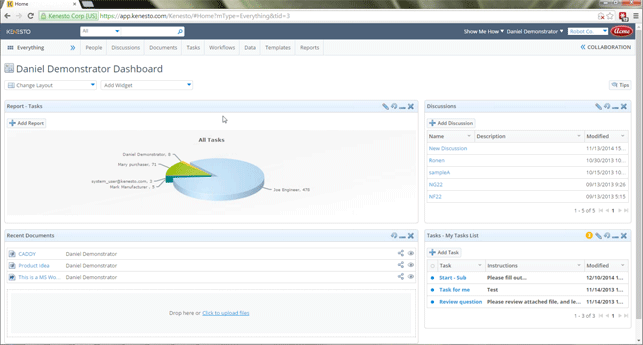PLM systems have a somewhat negative reputation in the engineering market. Many firms wrestle implementing them and sometimes end up being a lot more expensive than originally intended.

Kenesto’s dashboard
PDM, is much more popular but firms can end up running parallel systems in different departments or subsidiaries. A broader adoption of the cloud, which will eventually happen, however anyone feels about security will move both PLM and PDM to reside in the cloud because it will offer benefits in terms of cost, mobility and collaboration.
Kenesto originally started as a web-based engineering document process company for creating highly configurable worklows. Over time it has broadened into a ‘collaboration platform‘, offering many PLM and PDM capabilities as a cloud service, namely engineering change requests, bid proposals, and change orders.
The company is steered by industry veteran Mike Payne — responsible for the creation of Pro/Engineer, SolidWorks, SpaceClaim — and Stephen Bodnar, who oversaw PTC’s Windchill and more recently was integral to the development of Autodesk’s PLM 360 service.
Features
While the net result of Kenesto is the automation of complex workflows, the interface and use of templates enable a quick start. There are projects, workspaces and teams. Team members can be spread across many companies, divisions and geographic locations.
Workflows are constructed between team members in a highly graphical way, forms can be easily created and attached to activities, which prompt defined users to complete tasks within set timeframes, supports signature sign off.
Standard engineering processes like change requests can be constructed and visualised, Kenesto providing a full audit trail with reporting.
The service has a deep understanding of 3D model file formats and an extract bill of materials from assemblies and can be used to manage at the part level.
Kenesto Drive
Recently announced at SolidWorks World, Kenesto has reinvented the Network drive for SMEs with its cloud-based version ‘Kenesto Drive’.
You may think this could be Dropbox but this comes with all of Kenesto’s intelligence for automatic file versioning, file locking, automated back-up, sharing, assembly support, off-line access, document-centric discussions and project based file organisation.
Dropbox is really just a cloud drive, with no intelligence and only some basic recovery tools for deleted files. Kenesto’s seamless management layer provides a suite of PDM tools without being overbearing or obstructive to design teams. The automatic revisioning means nothing can be over written and with deep knowledge of the CAD formats can make sense of the assembly and BOM.
The Kenesto Drive solution needs no deployment as it’s a cloud service and extends an engineer’s current desktop environment as it looks the same as working locally.
There’s just enough PDM capabilities to be effective but not too many to overwhelm a small to medium sized company with PLM-level constraints. Kenesto Drive will be available in mid-March for subscribers to the Kenesto service.

All of your data and project information presented in a single web page
Conclusion
Kenesto is written in HTML5 and can run in any browser, or mobile device — Kenesto access is ubiquitous. As Kenesto doesn’t have a CAD solution it’s also independent and works with all the usual proprietary file formats.
The feature set is mature enough to compete against established server-based PDM and with workflow, even PLM systems but without a lot of the pain or the cost.
The introduction of Kenesto Drive is also a valuable offering for small firms that have started to utilise the web for storing and sharing files but are doing so without any degree of document management.
Being able to continue this, with the advantages of revision control alone, are a huge benefit. The additional functionality and collaboration features make it excellent value for money.
kenesto.com
| Product | Kenesto |
|---|---|
| Company name | Kenesto |
| Price | $25 per user per month |






